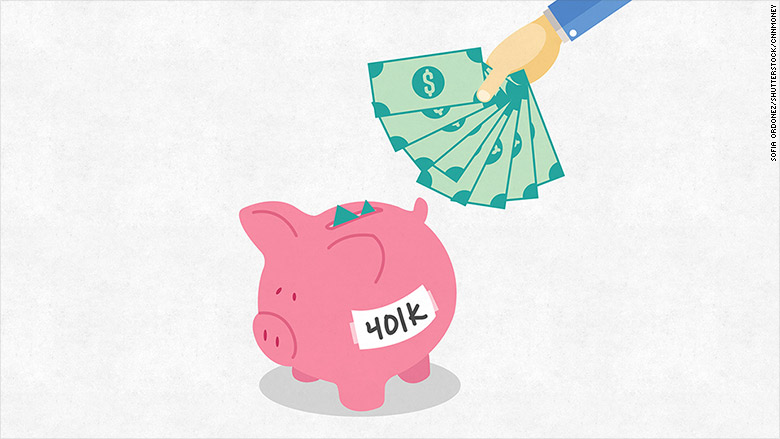
With 2016 about to go the way of the dinosaur, it's a great time to review your finances and decide how you're going to set yourself up for success in 2017. Here are three quick ways you can do that.
Move No. 1: Increase your deferrals
Now is a great time to take stock and see if you can make a small tweak in your monthly savings rate. Consider increasing your 401(k) contribution by a percentage point, which is small enough that it won't make much of a difference to your paycheck. This is extra easy if you get a pay raise at the end of the year -- you can make the adjustment simultaneously with your paycheck increase, so you won't even notice the change.
Your 401(k) comes with three key savings advantages:
Employer match. Many employers will match your contributions up to a certain dollar amount (a common split is they'll put in 3% if you put in 6%). You're leaving free money on the table if you aren't deferring enough to get the full match. In 2014, American workers left a whopping $24 billion on the table -- an average of $1,336 per employee who didn't defer up to the full employer match. That's an easy pay raise.
Automatic deferral. The money gets taken out of your paycheck before you see it. You'll forget about that extra money, which will enable it to grow quietly in the corner, building an awesome nest egg for your retirement.
Tax break. Contributions to traditional 401(k)s get deducted from your income taxes, meaning that you get a portion of every dollar you save back in tax breaks. Talk about an incentive to save!
Ok, so maybe I've convinced you to defer that extra 1 percentage point. Here's what a difference that can make.
Let's assume you make $75,000 annually and increase your savings by 1 percentage point (or $750 annually). If we assume an 8% annual rate of return in the stock market -- which is within historical averages -- after 30 years, you'd have... an extra $91,759 in savings. That isn't enough to retire on, but if you were already saving 9% and made it 10%, it's a nice extra chunk of change.
Move No. 2: Save your holiday bonus
According to a Bloomberg survey of HR staff and executives last year, 42% of companies plan to give out holiday bonuses to their employees. If we assume that percentage holds true this year, a lot of people are getting a little extra before the end of the year. If you're one of the lucky workers getting a monetary "thank you" from your boss, it's a no-brainer to put that money in savings. It isn't money that you're depending on (hopefully), so it should be relatively painless to save it for the future.
Consider opening an IRA, which can give you an immediate tax break and allow your money to grow tax-deferred from now until retirement. You can contribute up to $5,500 for this year -- $6,500 if you're 50 or older -- and you can make a tax-deductible contribution for the 2016 tax year any time between now and Apr. 17, 2017.
Move No. 3: Save on gifts, pay down debt
Gift giving is inherently pretty nerve-wracking. You want to be generous and thoughtful, while not breaking the bank. That's a tough line to walk, and it shows: According to American Research Group's survey on planned spending, Americans intend to spend a whopping $929 on holiday gifts this year. When you compare that to 1985's planned spending, that's a whopping 43% increase in inflation-adjusted dollars.
There's a better (and cheaper) way. You can give people experiences instead of physical gifts, and they come with a series of benefits. Giving an experience usually highlights how well you know someone and how they like to spend their time. Checkmark for thoughtfulness.
According to a study by researchers at San Francisco State University published in The Journal of Positive Psychology, experiences contribute more to happiness than material possessions -- and people tend to view them as a better use of money, too. Now, the research involved people purchasing experiences and material possessions for themselves, but it's reasonable to assume that similar trends would probably apply when the two are received as gifts. Checkmark for generosity.
Finally, experiences can be cheap (or even free). If a friend likes nature, set aside an afternoon for an outdoor hike. If one likes art, take them to the (free) opening of a new art gallery. You get the idea.
Let's say you reduce your holiday spending by $500, and instead use that money to pay down credit card debt that you've been sitting on for awhile. (This is more common than you probably think -- according to the American Bankers Association, 42.1% of credit card accounts are held by so-called "Revolvers," or people who carry a balance month to month.)
That's a twofer: Not only are you reducing debt by $500, but chances are good the additional $500 would have been added right to your credit card. So saving $500 and applying it to your debt actually reduces the amount of debt you would have otherwise had by $1,000. That adds up to big bucks. Assuming an 18% interest rate, and that alternatively you would have made a minimum payment of $25 per month, you just saved $539 in interest payments over the next five years and two months.
Sponsored Content from The Motley Fool:
• 5 Years From Now, You'll Probably Wish You Grabbed These Stocks
• Kansas Man Turns $10,000 into $8 Million
• Shark Tank Just Revealed a Trillion-Dollar Idea
Get ahead of the game
New Year's is right around the corner. Why not get ahead of that inevitable New Year's resolution to save more?
